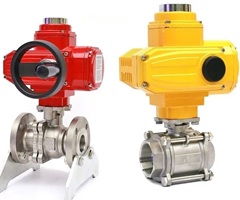


Troubleshooting Common Faults in Motorized Control Valves
Troubleshooting Common Faults in Motorized Control Valves
We are a leading control valve manufacturer in China, providing high-quality valves and control actuators customized to meet a wide range of industrial applications.
Motorized control valves are vital to modern industrial systems, providing accurate regulation of fluid flow, pressure, and temperature. Their integration with electric actuators allows for enhanced automation and precision across a variety of applications. However, like all mechanical devices, motorized control valves are susceptible to faults that can impair their performance.
Understanding these common issues—and implementing the right solutions—is essential to maintaining system efficiency, minimizing downtime, and avoiding costly repairs. Below, we explore the most frequent faults found in motorized control valves and offer practical guidance for prevention and resolution.
Description:
When a valve fails to move smoothly between positions, it leads to inaccurate flow control and can disrupt process stability.
Common Causes:
Fouling: Debris or contamination inside the valve body.
Corrosion: Rust or oxidation of internal components, especially the stem.
Lack of Lubrication: Increased friction due to insufficient lubrication.
Solutions:
Schedule routine cleaning to prevent buildup.
Use corrosion-resistant materials for parts exposed to harsh environments.
Establish a regular lubrication schedule for moving components.
Description:
A faulty actuator prevents the valve from opening or closing properly, compromising control and system responsiveness.
Common Causes:
Electrical Problems: Faulty wiring, connectors, or unstable power supply.
Mechanical Wear: Internal components degrade over time.
Overheating: Excessive heat can damage actuator electronics.
Solutions:
Perform regular electrical inspections and test voltage inputs.
Replace worn actuator components as part of scheduled maintenance.
Implement cooling measures or thermal protection for the actuator.
Description:
A malfunctioning positioner causes the valve to respond inaccurately to control signals, leading to poor regulation.
Common Causes:
Calibration Drift: Positioner accuracy degrades over time.
Signal Interference: Electrical noise distorts input signals.
Internal Mechanical Failure: Wear or damage affects performance.
Solutions:
Conduct periodic calibration to ensure accurate positioning.
Use shielding and signal filters to reduce electromagnetic interference.
Inspect and maintain mechanical components regularly.
Description:
Seal failures allow fluid to leak past the valve seat, reducing process control efficiency and potentially causing safety risks.
Common Causes:
Seal Wear: Degradation due to repeated cycling or aggressive fluids.
Incorrect Installation: Misalignment or poor fit during assembly.
Pressure Surges: Sudden fluctuations can damage seals.
Solutions:
Replace worn or damaged seals as part of regular servicing.
Follow manufacturer guidelines for proper installation.
Stabilize system pressure to minimize stress on seals.
Description:
Hysteresis refers to a delay or lag between the input signal and the valve’s physical movement. It can lead to control inaccuracy.
Common Causes:
Friction within the valve mechanism.
Backlash in gears or linkages.
Poorly Tuned Control Loops that don’t compensate for system delays.
Solutions:
Apply lubrication and perform friction checks.
Use high-precision mechanical components to reduce backlash.
Tune control loops to enhance responsiveness and minimize lag.
Description:
Unusual noise or vibration may signal mechanical stress or operational inefficiencies—and can accelerate wear if left unaddressed.
Common Causes:
Cavitation due to rapid pressure changes.
Flow Turbulence from poor piping design or valve sizing.
Component Misalignment creating mechanical instability.
Solutions:
Use anti-cavitation trims or control pressure drops to avoid cavitation.
Optimize flow paths and valve selection to minimize turbulence.
Perform regular alignment checks during inspections.
Motorized control valves are indispensable for achieving accurate, safe, and efficient process control across a range of industries. However, their performance can be compromised by common faults such as valve sticking, actuator failure, positioner malfunction, seal leakage, hysteresis, and excessive noise or vibration.
By identifying these issues early and implementing proactive maintenance practices—such as regular cleaning, calibration, lubrication, and proper installation—operators can enhance valve reliability and extend system lifespan. Investing in proper diagnostics and preventive strategies ensures smoother operations, fewer unplanned shutdowns, and long-term operational success.Know more about Google SEO Directory
